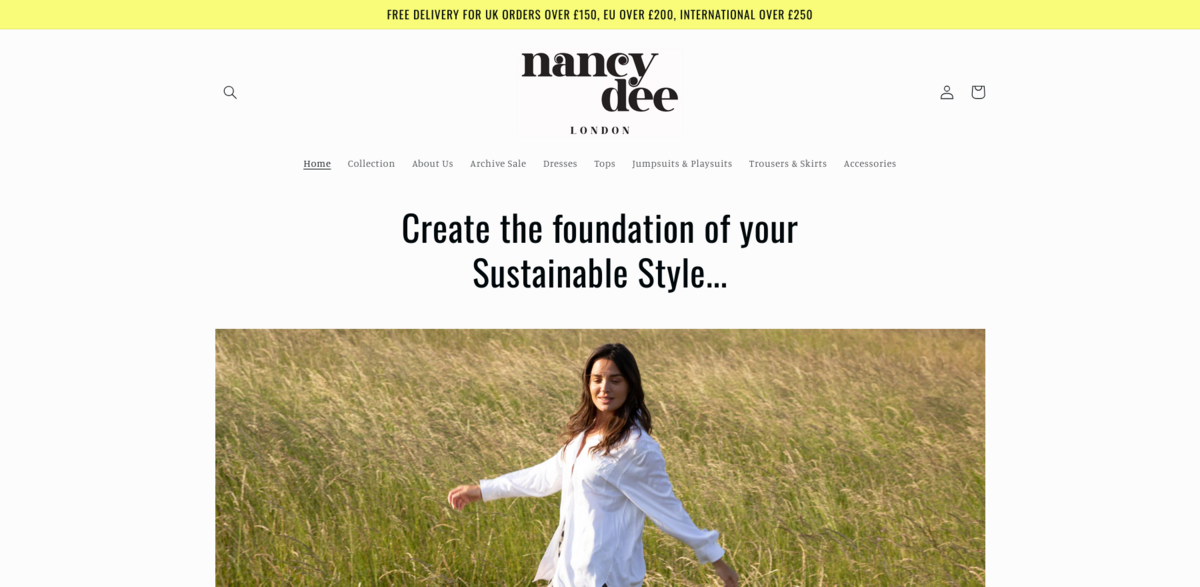Discover Nancy Dee: Sustainable Style with a British Heart
Nancy Dee is all about creating the foundation of your sustainable style… Exclusively designed and made in Britain, this label brings together style, comfort, and responsibility. Founded in 2008 by Seraphina Davis, Nancy Dee believes that responsible fashion doesn’t mean compromising on quality or design. Instead, it offers a capsule collection of wardrobe staples that effortlessly transition from day to night, season to season. It’s fashion for the everyday city-lover who wants to look good and feel good about their choices.
The Main Benefit: Style Meets Sustainability
What really sets Nancy Dee apart? It’s the perfect blend of style and sustainability, wrapped up in versatile pieces that last. Here are some key highlights:
- Uses only the very best sustainable fabrics, including bamboo, linen, and organic cotton.
- Incorporates deadstock fabrics sourced in the UK, upcycled into unique designs.
- All garments are manufactured to the highest standards right here in Britain.
- Small factories and local businesses are prioritized to support ethical production.
- Strict adherence to UK and EU working regulations ensures fair labor practices.
Craftsmanship Rooted in British Tradition
Nancy Dee nurtures and promotes the specialist skills that have long established Britain’s reputation for quality manufacture. By working with small factories, the brand maintains direct communication with the people who make the garments, ensuring every piece meets exacting standards. This hands-on approach not only guarantees quality but also supports local economies and preserves traditional craftsmanship.
Thoughtful Fabric Choices and Production
Fabric selection is a big deal at Nancy Dee. The brand takes utmost care to source sustainable materials, mixing natural fibers like bamboo, linen, and organic cotton. But it doesn’t stop there. Deadstock fabrics, which might otherwise go to waste, are sourced locally and upcycled into fresh, stylish designs. Patterns are cleverly designed to minimize fabric wastage, and leftover materials get a second life as samples or new creations. It’s all about reducing environmental impact at every step.
Eco-Friendly Practices Beyond the Garment
It’s not just about the clothes. Nancy Dee’s commitment to sustainability extends throughout the entire production cycle. From recommending low-temperature washing and line-drying to using acid-free tissue paper and recyclable packaging, every detail counts. The brand also embraces technology to cut down on travel, opting for video conferencing whenever possible and driving electric cars when travel is necessary. Local sourcing for printing, labeling, and packaging further reduces transport emissions and supports nearby businesses.
Impacting Sustainable Development Goals (SDGs)
- SDG 12: Responsible Consumption and Production
- SDG 8: Decent Work and Economic Growth
- SDG 13: Climate Action
- SDG 9: Industry, Innovation, and Infrastructure
- SDG 15: Life on Land
Building a Capsule Collection That Lasts
The Nancy Dee capsule collection is designed to be your go-to wardrobe foundation. Each piece is versatile, timeless, and crafted to last through changing seasons and trends. Whether it’s trousers and skirts inspired by everyday life or unique dresses that become staples, the collection encourages a truly sustainable lifestyle. It’s about investing in quality, reducing waste, and embracing fashion that feels good inside and out.





















